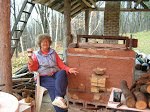There are several themes that I decided to pursue. First I decided to continue with the stone fence theme from our farm. The huge fences remain as evidence of an earlier age when hard work was the norm. The fences are made from glacial granite boulders and as there were few flat stones building these fences was not easy. I often look at those carefully placed stones and imagine how the calloused hands of the farmer were the last ones to touch those stones over 100 years ago.
I thought I might start the stone fence and then turn it into a pot and then turned it back into the fence again. However that prototype turned out rather ungainly and so I abandoned it, though I will think about it some more. I decided to do what I had done previously, the fence coming from just one side - so not very original but I think right now it is to get as many things out there and see where they will lead. I find the forest on our farm very magical - mysterious at times and full of spirits of the past as many areas of what once were fields have now returned back to the forest, with only overgrown stone fences cutting straight lines through the trees. It is certainly easy to breathe the air there - it is pure and cleansing. So I keep coming back to stone fences and trees. Some suggestions from the meeting were to extend the vase - add wings to make it bigger. That reminded me that I had really gotten into a rut with these slab vases - all basically the same shape. So will have to work on that.
 |
| Forest vase with stone fence at end |
 |
| It was suggested that pot shape had possibilities without the stones - will try to make bottoms more interesting, |
 |
| Sketch - lots of faces with hands reaching out for a dangling fish. - kind of representing the bottom billion. |
 |
| What I ended up with - not sure what it represents. |
 |
| On left - the slab template was to be another stone fence theme. On right a singing lady from thrown pot |
 |
| Trio of pots - trying to show lots of movement - sort of go-go girls from the 1960's. |
 |
| Slab pot from stone fence template - ended rounding up the areas to fill them out. It ended up rather stilted as the top stick up too stiffly- I think thrown will give it more movement. |
 |
| Nuclear? Be happy! |











